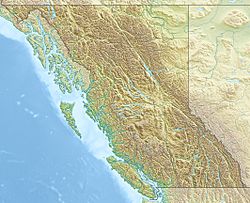Triple Island Lightstation facts for kids
|
|
|
| Location | Brown Passage 25 miles (40 km) W of Prince Rupert British Columbia Canada |
|---|---|
| Coordinates | 54°17′41″N 130°52′50″W / 54.294830°N 130.880505°W |
| Year first constructed | 1920 |
| Year first lit | 1921 |
| Construction | concrete tower |
| Tower shape | octagonal tower with balcony and lantern attached two a two-story keeper's house |
| Markings / pattern | white tower, red balcony and lantern |
| Height | 21.9 metres (72 ft) |
| Focal height | 28 metres (92 ft) |
| Range | 16 nautical miles (30 km; 18 mi) |
| Characteristic | Fl (2) W 9s. |
| Fog signal | deactivated |
| Admiralty number | G5812 |
| CHS number | CCG 0752 |
| NGA number | 11460 |
| ARLHS number | CAN-508 |
The Triple Island Lighthouse is a large lighthouse located on Triple Island in British Columbia, Canada. It is a "manned" station, meaning people live and work there to keep it running. This important building helps guide ships safely through the waters.
The lighthouse was built in 1920, and it took four years to complete. It is made of strong concrete. The main part is a tall tower, about 21.9 metres (72 ft) (72 feet) high. This tower is connected to a rectangular building. This building is where the lighthouse keepers live and where the machinery for the light is kept.
A special landing area for helicopters, called a helipad, takes up a lot of space on the small island. This helipad is used to bring supplies and new staff to the lighthouse. Workers from the Canadian Coast Guard live and work at the station. They usually stay for 28 days at a time before new staff arrive. In 1974, the Triple Island Lighthouse was named a National Historic Site of Canada. This means it is a very important place in Canadian history.
Contents
What is the Triple Island Lighthouse?
The Triple Island Lighthouse is a crucial navigation aid for ships. It helps them find their way in the ocean, especially at night or in bad weather. Lighthouses like this one shine a bright light that ships can see from far away.
How Does a Lighthouse Work?
A lighthouse uses a powerful light to send signals to ships. The light at Triple Island Lighthouse flashes white twice every 9 seconds. This unique pattern helps sailors know exactly which lighthouse they are seeing. The light can be seen up to 16 nautical miles (30 km; 18 mi) (about 30 kilometers or 18 miles) away.
Who Works at the Lighthouse?
Lighthouse keepers are the people who live and work at the station. Their job is to make sure the light is always working. They also keep the equipment in good condition. It's a demanding job because they live far from cities and have to be ready for all kinds of weather.
History of the Triple Island Lighthouse
The lighthouse has been helping ships for over 100 years. It was built to make shipping safer along the coast of British Columbia.
Collecting Ocean Data
From 1939 to 1970, the Triple Island Lighthouse was part of a special science program. This program was called the British Columbia Shore Station Oceanographic Program. For 31 years, the lighthouse keepers collected information about the ocean every single day.
- They measured the temperature of the coastal water.
- They also measured the salinity of the water. Salinity tells us how much salt is in the water.
This information was sent to the Department of Fisheries and Oceans. It helped scientists understand the ocean better and how it affects fish and other sea life. This long record of data is very valuable for studying changes in the ocean over time.


